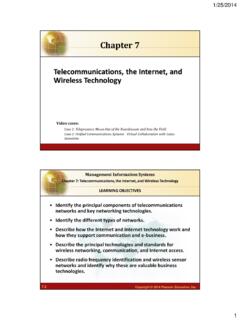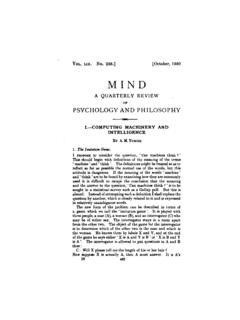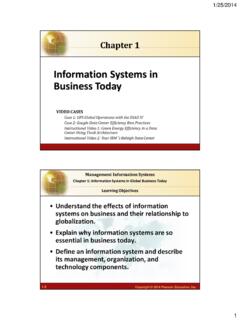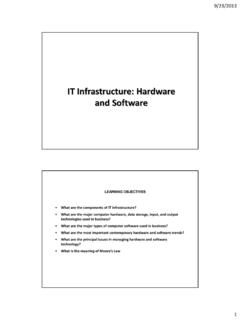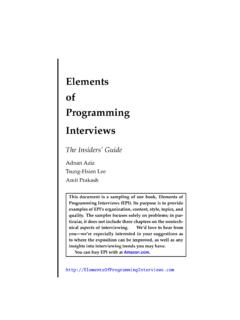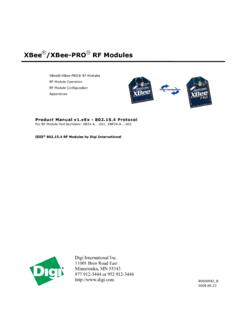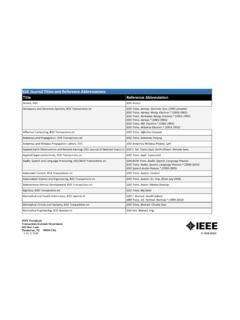Transcription of IT Infrastructure: Hardware and Software
1 9/23/2013 1 IT Infrastructure: Hardware and Software LEARNING OBJECTIVES What are the components of IT infrastructure? What are the major computer Hardware , data storage, input, and output technologies used in business? What are the major types of computer Software used in business? What are the most important contemporary Hardware and Software trends? What are the principal issues in managing Hardware and Software technology? What is the meaning of Moore s Law 9/23/2013 2 IT Infrastructure: Computer Hardware IT infrastructure: provides platform for supporting all information systems in the business Computer Hardware Computer Software Data management technology Organizes, manages, and processes business data concerned with inventory, customers, and vendors Networking and telecommunications technology Technology services , consultants for systems integration with legacy systems Infrastructure Components IT Infrastructure Components IT Infrastructure.
2 Computer Hardware Figure 4-1 A firm s IT infrastructure is composed of Hardware , Software , data management technology, networking technology, and technology services. 9/23/2013 3 Moore s Law Moore s Law predicts that the number of transistors fitting on a computer chip will double every one and a half to two years. This prediction about density also captures advances in processing speed, storage capabilities, cost, and other component features. Processing power and speed and storage capabilities have increased exponentially as the cost of computing devices has decreased. Computers come in different sizes with varying capabilities for processing information.
3 FLOPS (Floating point operations per second) Smartphones, netbooks, e-book readers Today s smartphones are far more powerful than the early PCs of the 1980s PCs Workstations More powerful mathematical and graphics-processing capabilities than a PC Used primarily for advanced design or engineering work requiring powerful graphics or computational capabilities. Types of Computers IT Infrastructure: Computer Hardware 9/23/2013 4 Servers: Type of midrange computer. Support computer network, sharing files and resources. Provide Hardware platform for e-commerce. Mainframes: Large-capacity, high-performance computer that can process large amounts of data very rapidly , used by airlines for thousands of reservations per second Mainframes are still a major revenue and profit source for IBM, one of the last large-scale commercial manufacturers of mainframe computers.
4 They are used often as huge Web servers where they are more efficient than tens of thousands of PCs in processing large volumes of records Types of Computers IT Infrastructure: Computer Hardware Supercomputer: More sophisticated computer used for tasks requiring extremely rapid and complex calculations with thousands of variables, millions of measurements Used in engineering, scientific simulations, military/weapons research, weather forecasting Grid computing: Video Power of geographically remote computers connected into single network to act as virtual supercomputer Types of Computers IT Infrastructure: Computer Hardware 9/23/2013 5 Client/server computing: Form of distributed computing Splits processing between clients and servers Clients: user point of entry The user generally interacts directly only with the client portion of the application, often to input data or retrieve data for further analysis.
5 Servers: store and process shared data and perform network management activities Types of Computers IT Infrastructure: Computer Hardware Client/Server Computing IT Infrastructure: Computer Hardware Figure 4-2 In client/server computing, computer processing is split between client machines and server machines linked by a network. Users interface with the client machines. 9/23/2013 6 Storage, Input, and Output Technology IT Infrastructure: Computer Hardware Primary secondary storage technologies Magnetic disk: Hard drives, USB flash drives RAID: can package hundreds of drives for massive storage requirements Optical disks CD-ROM, CD-RW, DVD Magnetic tape Storage networking: SANs Connect multiple storage devices on a separate high-speed network dedicated to storage A Storage Area Network (SAN) IT Infrastructure: Computer Hardware A typical SAN consists of a server, storage devices, and networking devices, and is used strictly for storage.
6 The SAN stores data on many different types of storage devices, providing data to the enterprise. The SAN supports communication between any server and the storage unit as well as between different storage devices in the network. SANs are an effort by corporations to reduce storage costs, manage information, increase flexibility, and provide near-certain backup. One of the major worries of business firms is losing customer or other digital data. Extraordinary efforts are taken to make redundant copies of digital information, and placing it on separate secure servers, even remote servers in separate facilities. 9/23/2013 7 Storage, Input, and Output Technology IT Infrastructure: Computer Hardware Input devices: Gather data and convert them into electronic form.
7 Keyboard Computer mouse Touch screen Optical character recognition Magnetic ink character recognition Pen-based input Digital scanner Audio input Sensors Storage, Input, and Output Technology IT Infrastructure: Computer Hardware Output devices: Display data after they have been processed. Monitor Printer Audio output Information systems collect and process information in one of two ways. Batch processing: transactions stored for predefined amount of time, then processed as group Online processing: transactions processed immediately 9/23/2013 8 Contemporary Hardware Trends IT Infrastructure: Computer Hardware The emerging mobile digital platform Based on new handheld Hardware like cell phones, netbooks, and tablet computers.
8 A new platform. wireless communications through 3G cell networks and Wi-Fi. New Software apps. Nanotechnology: video Uses individual atoms and molecules to create computer chips and other devices that are thousands of times smaller than current technologies permit. Nanotechnology shrinks the size of transistors down to the width of several atoms. Examples of Nanotubes IT Infrastructure: Computer Hardware Figure 4-5 Nanotubes are tiny tubes about 10,000 times thinner than a human hair. They consist of rolled up sheets of carbon hexagons, have potential uses as minuscule wires or in ultrasmall electronic devices, and are very powerful conductors of electrical current.
9 9/23/2013 9 Contemporary Hardware Trends IT Infrastructure: Computer Hardware Cloud Computing: video A model of computing in which firms and individuals obtain computing resources over the Internet Cloud infrastructure as a service customers use processing, storage, networking, and other computing resources from cloud service providers to run their information systems. Cloud platform as a service customers use infrastructure and programming tools hosted by the service provider to develop their own applications. Cloud Software as a service customers use Software hosted by the vendor. Top Free Cloud Computing Software Cloud Advantages Eliminates need for large up-front capital investments in systems Eliminates lengthy implementations on corporate computers Low cost subscriptions.
10 No expensive licensing and maintenance fees No Hardware for subscribers to purchase, scale, and maintain No operating systems, database servers or applications servers to install No consultants and staff Accessible via standard Web browser with behind-the-scene Software updates Better scalability, eliminate cost and complexity of managing multiple layers of Hardware and Software 9/23/2013 10 Cloud Disadvantages May not be attractive to larger companies for their application needs Responsibility of data storage and control is in the hands of the provider Security risks may increase and open vulnerabilities to data maintenance System reliability issues Users dependency on the cloud computing provider Cloud Computing Platform IT Infrastructure: Computer Software Figure 4-6 In cloud computing, Hardware and Software capabilities are provided as services over the Internet.
